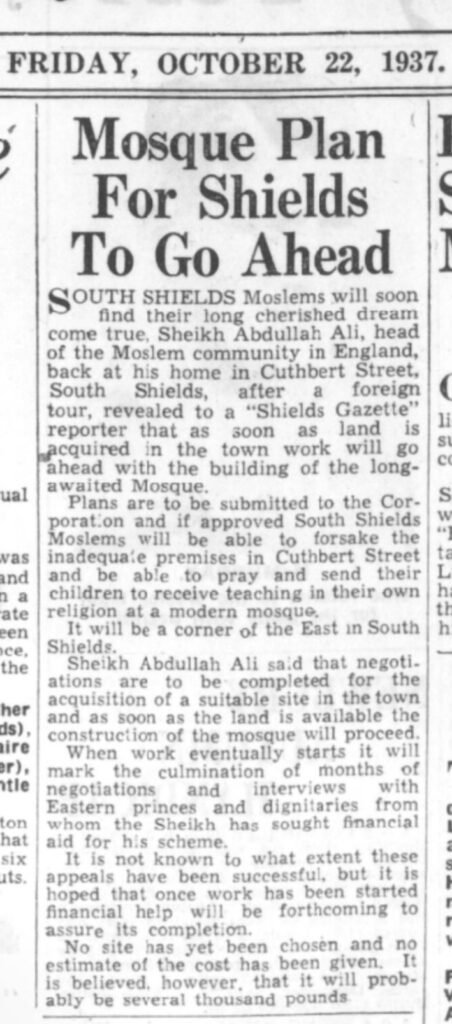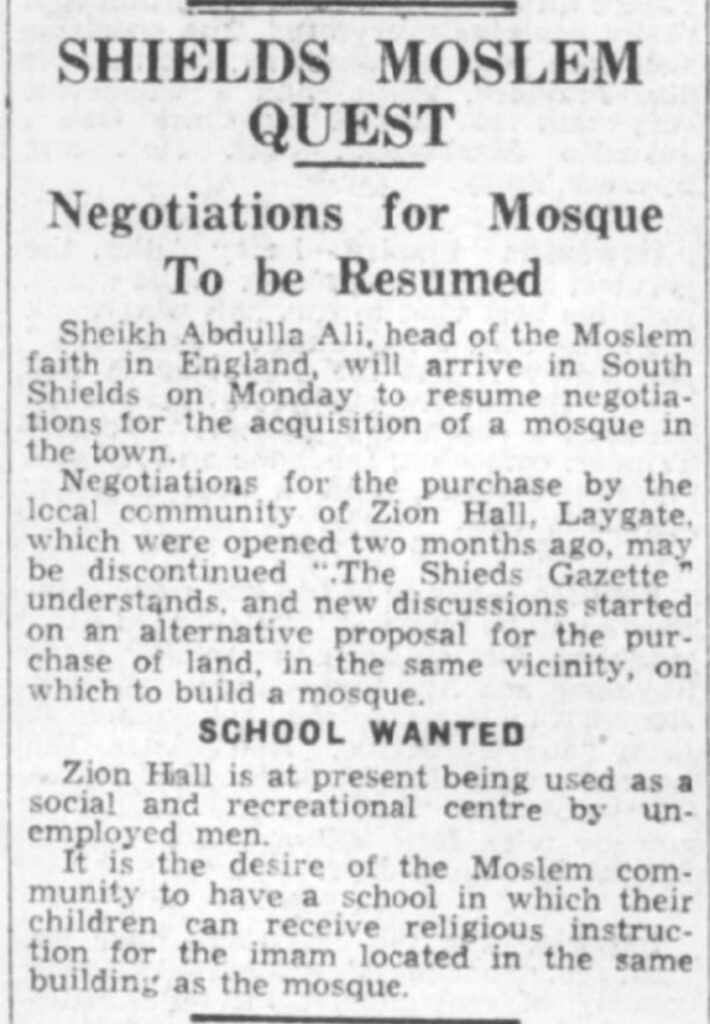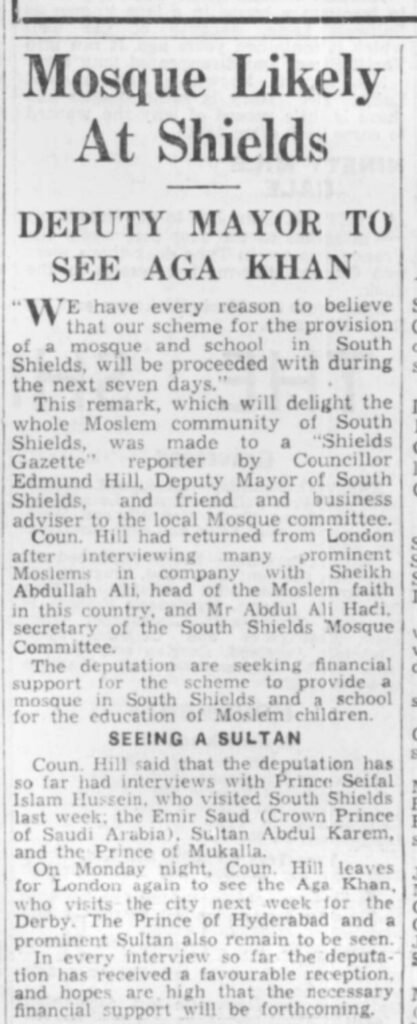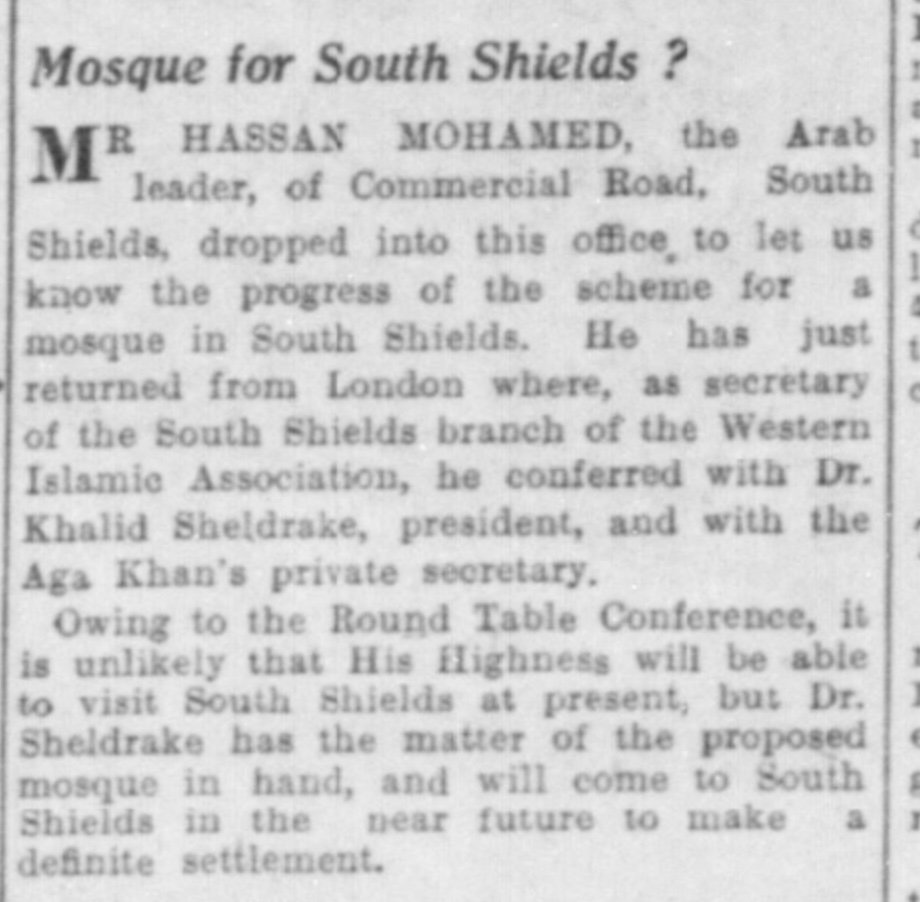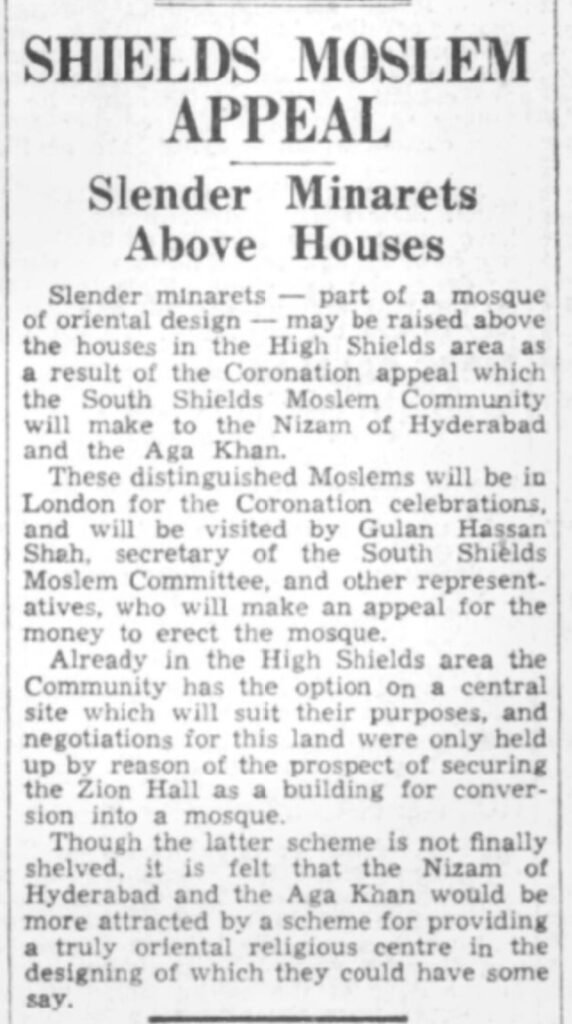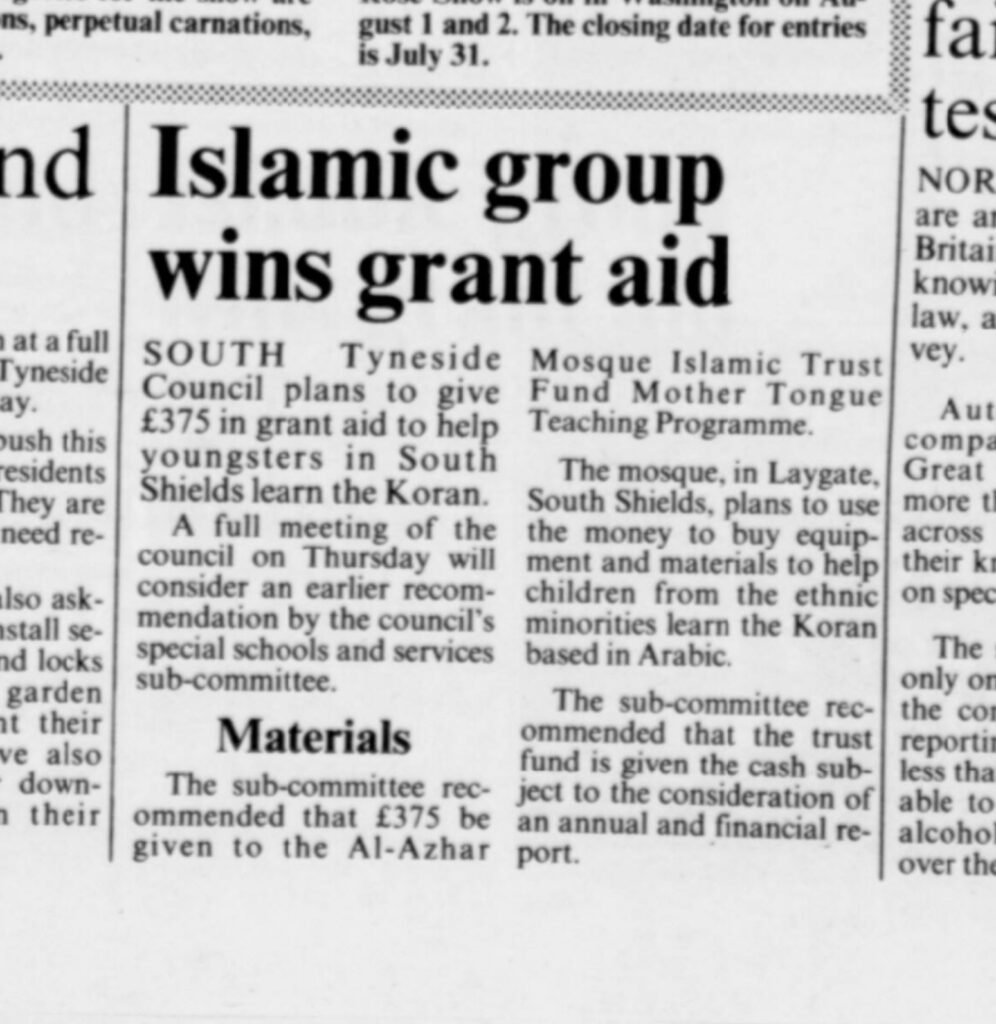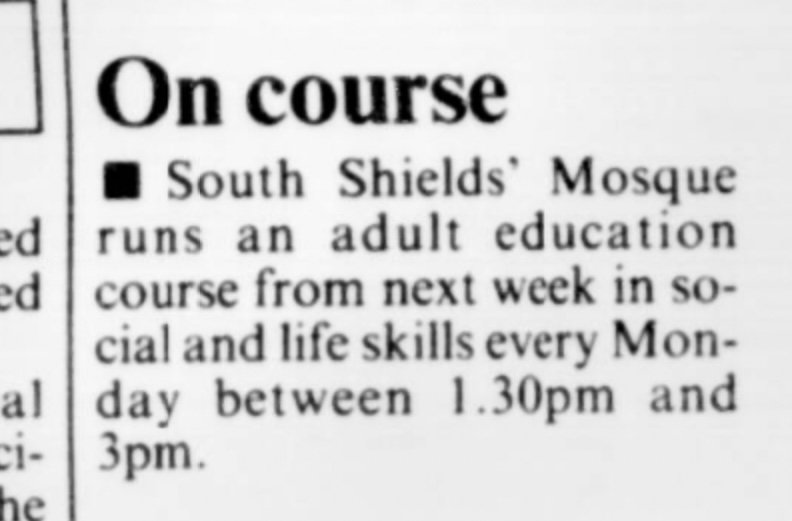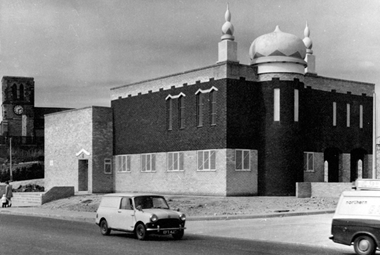
The Zaoia’s & Britain’s First Purpose Built Mosque
1929- The dream of building a mosque begins
From their arrival in South Shields and documented as early as 1929, the Arab population sought to obtain a specialised place of worship to accommodate their religious needs.
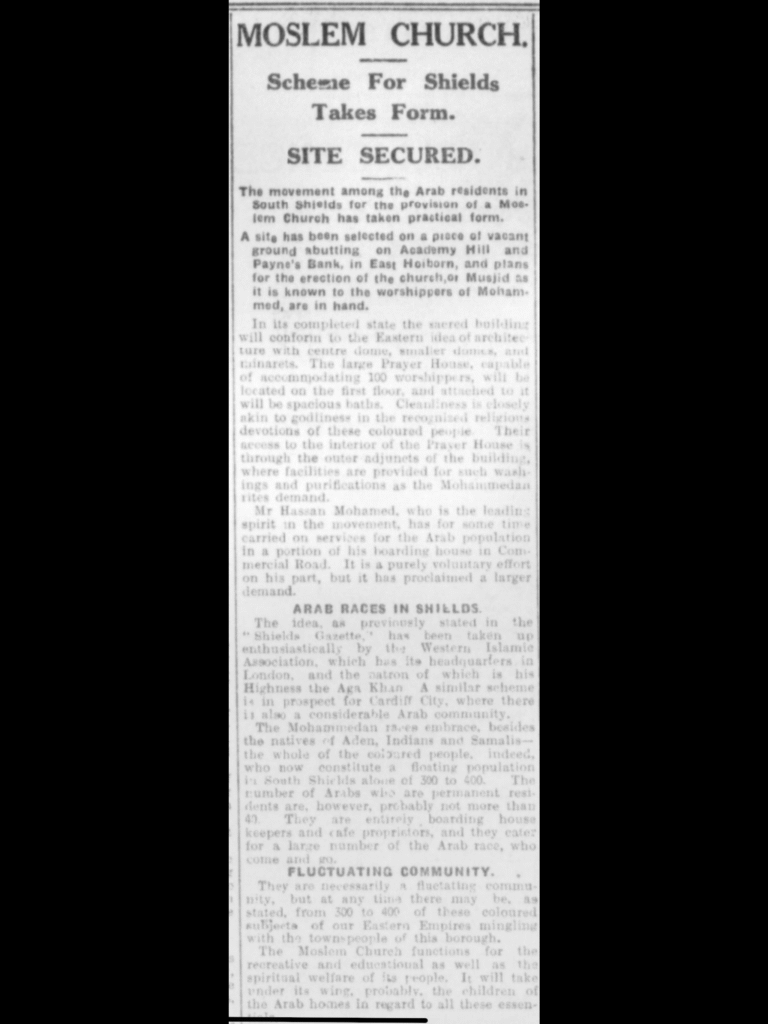
(c) The Shields Gazette 21/09/1929
1930s
In the 1930s, Sheikh Abdullah Ali Al-Hakimi established his ‘Zaoia Allaouia Islamic Mosque’ on Cuthbert Street. To do this, the Hilda Arms was converted. The Shiekh himself used the floors above the establishment for his own personal living space.
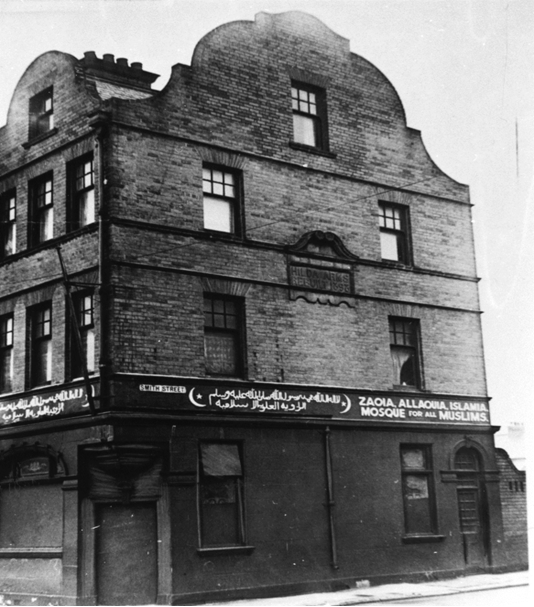
© South Tyneside Libraries
Sheikh Abdulla Ali Al-Hakimi was leading an influential figure within the Muslim Yemen community in the 1930s and 1940’s.

(c) Shields Gazette 30th July 1937
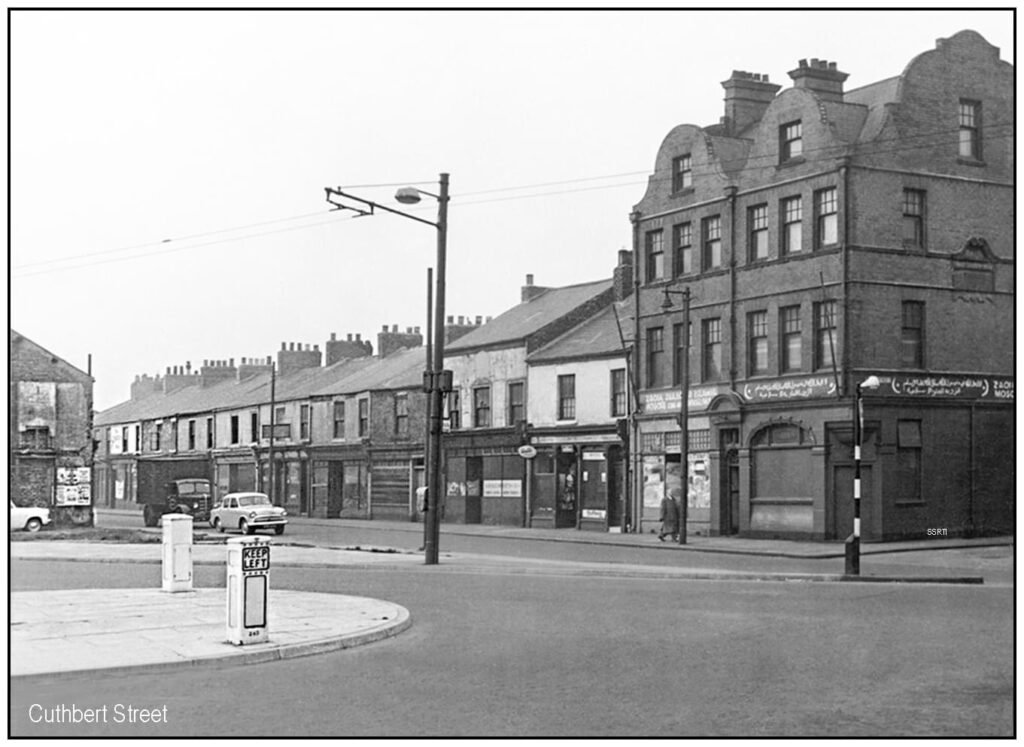

Early attempts to Build a Mosque
Attempts to secure a site and raise funds featured frequently in the Shields Gazette across the 1930’s. There were pitches made to the Aga Khan and meetings also occurred with Saif-al Islam, son of the ruling Imam Yahya of Yemen who visited South Shields. The articles taken from the Gazette below demonstrate the tenacity and favourable reporting with which this issue was met. Councillor Edmund Hill (who also served as mayor for a time) was notably favourable and accommodating to the Arab community and deserves recognition.
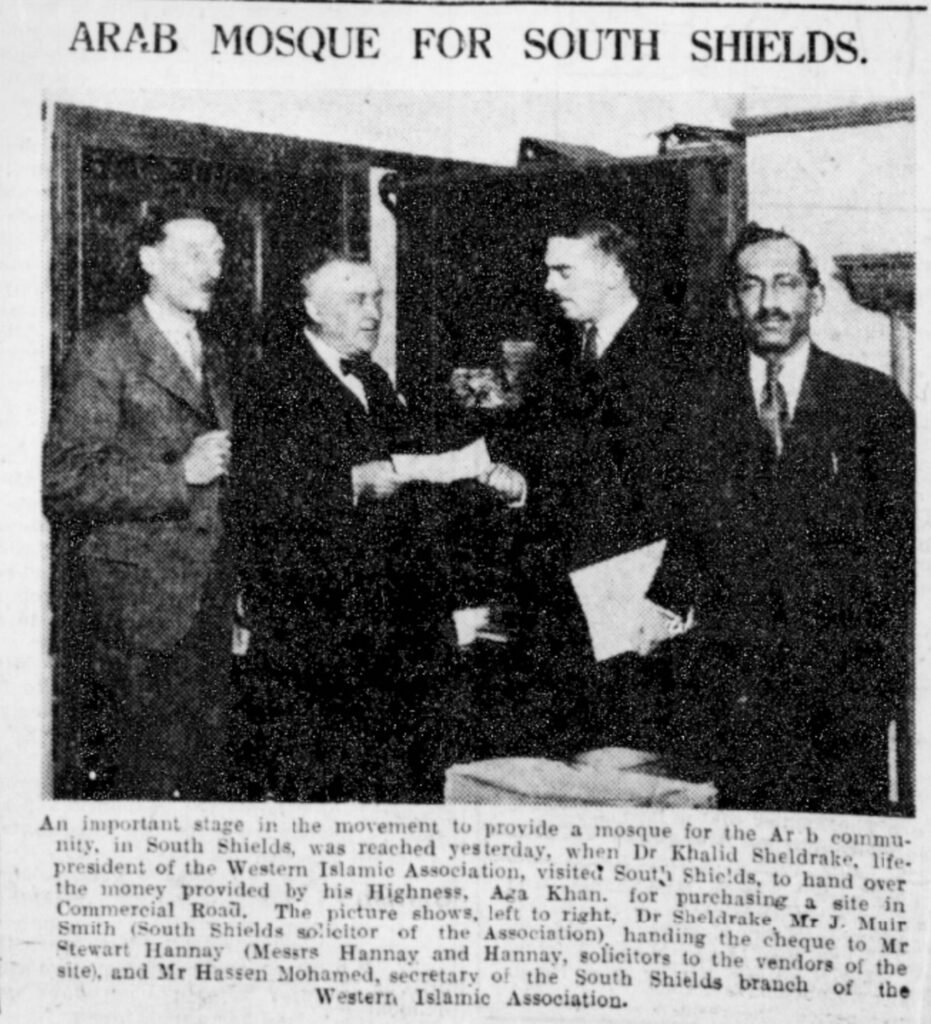
(c) The Shields Gazette 09/09/1930

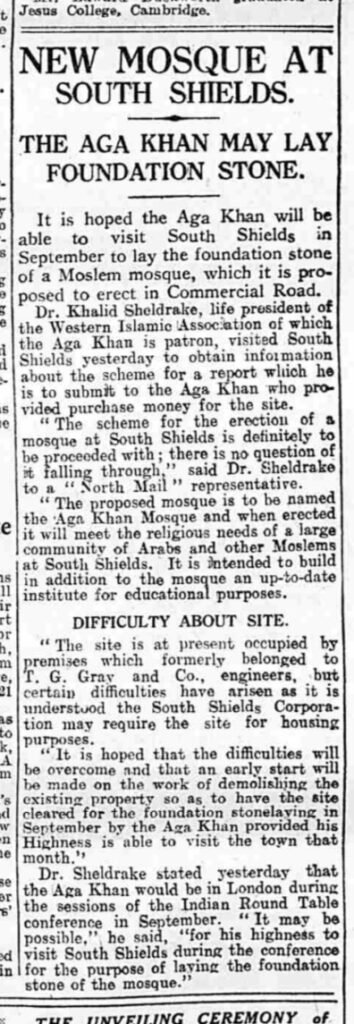

The Aga Khan 12
(c) The Shields Gazette 31/05/1937
Who was the Aga Khan? A leading Islamic figure
(c) British Pathe
Prince visits the Arab Community

(c) The Shields Gazette 26/04/1934
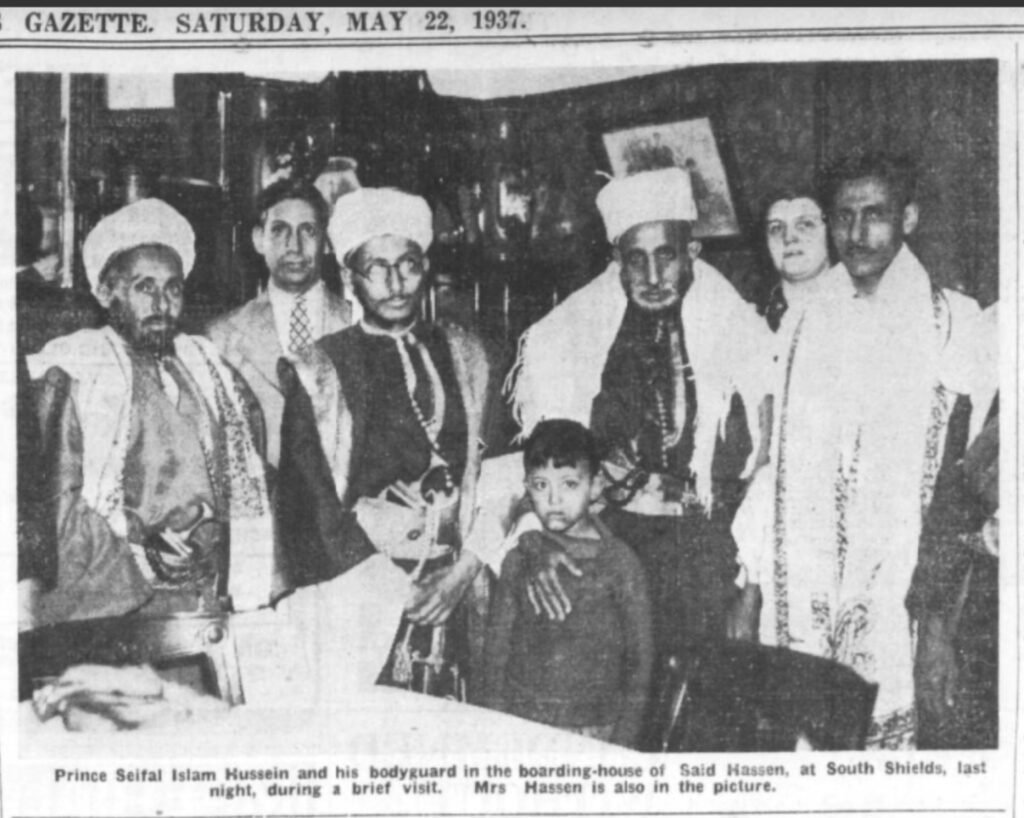
(C) The Shields Gazette 22/05/2937
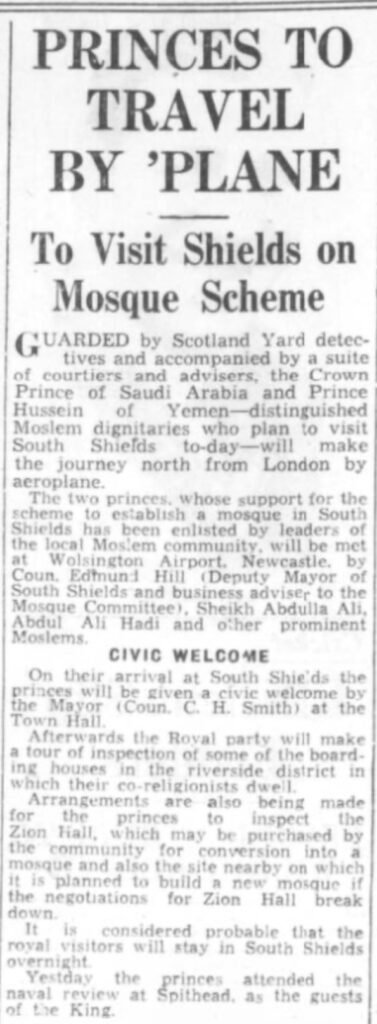
(c) The Shields Gazette 21/05/1937
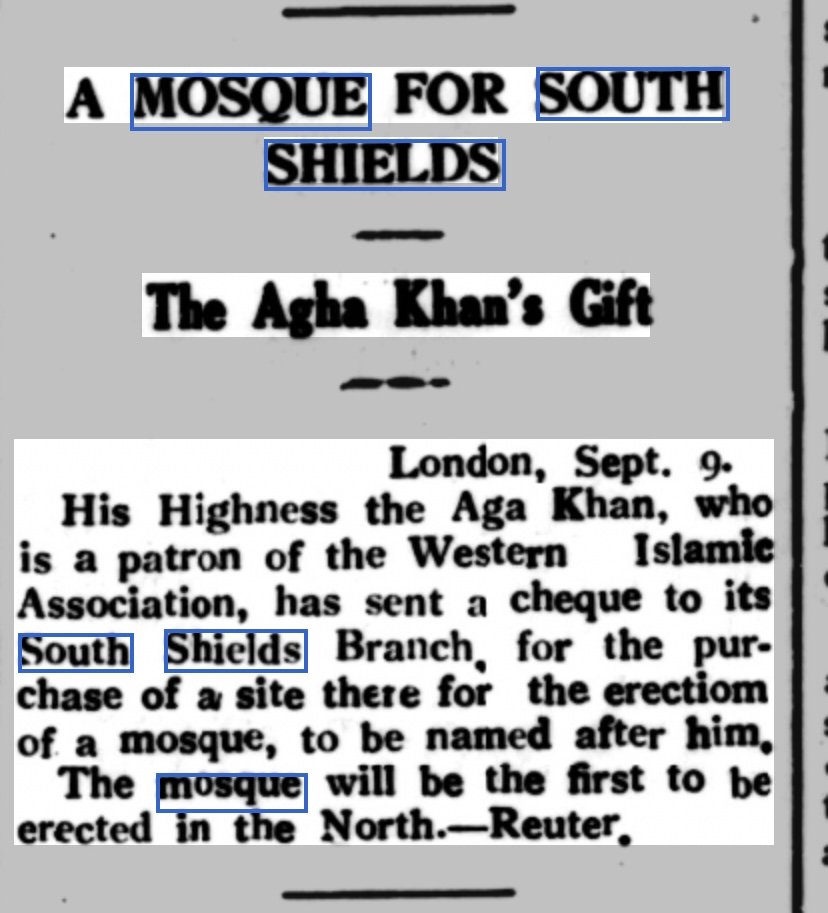
(c) The Shields Gazette 31/05/1937
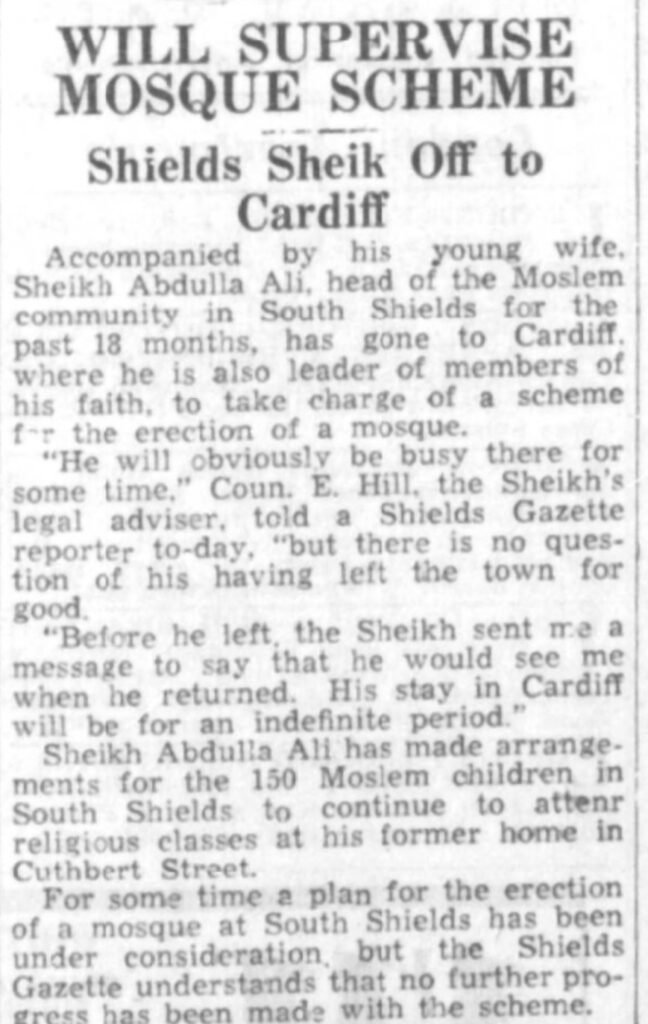
(c) The Shields Gazette 06/05/1938
religious life
The arrival of Abdullah Ali to South Shields put a fresh focus on the religious life of the Arab seamen in South Shields. Aside from working to establish suitable space to pray, the Sheikh put effort into teaching the Muslim children about their religion. He started the tradition of pageantry and celebratory marches making visible Islamic displays within South Shields. He conducted Islamic marriages, keen to see that Muslims marry according to the conditions set in the Quran and the teachings of the Prophet Muhammad (ﷺ). This was welcomed by local authorities who were of the opinion that the pre-occupation of Arabs with their faith would prevent them from challenging the status quo.

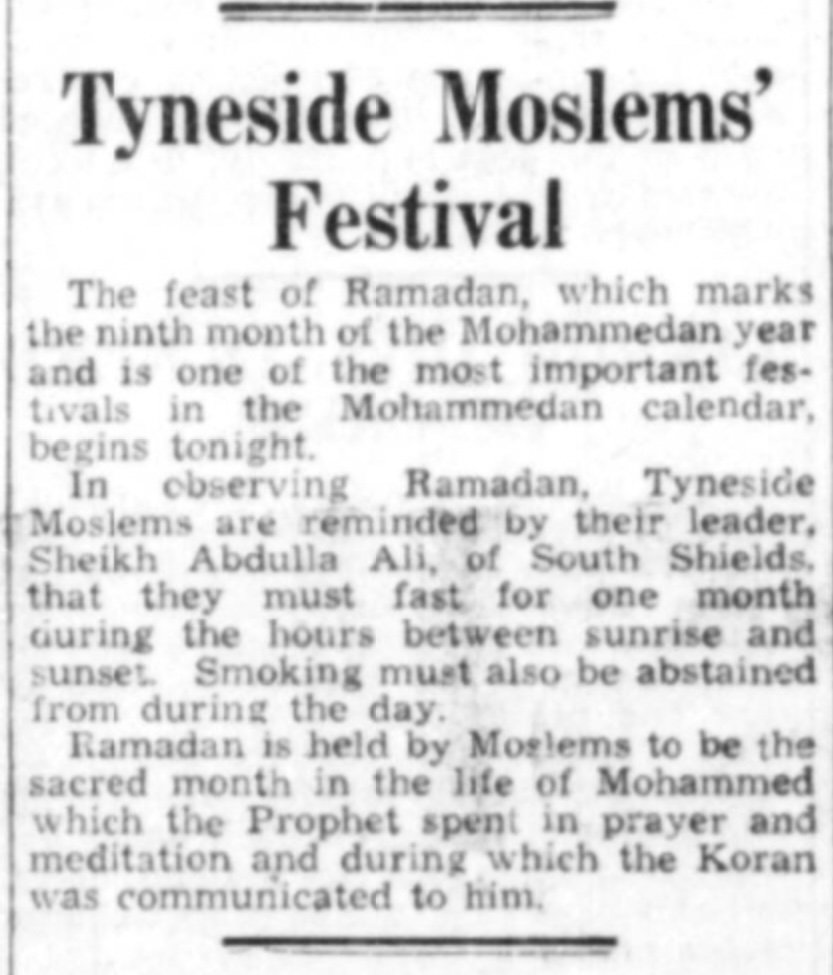
(c) The Shields Gazette 13/10/1939

(c) The Shields Gazette 01/10/1940
(c) Shields Gazette 06/12/1937,
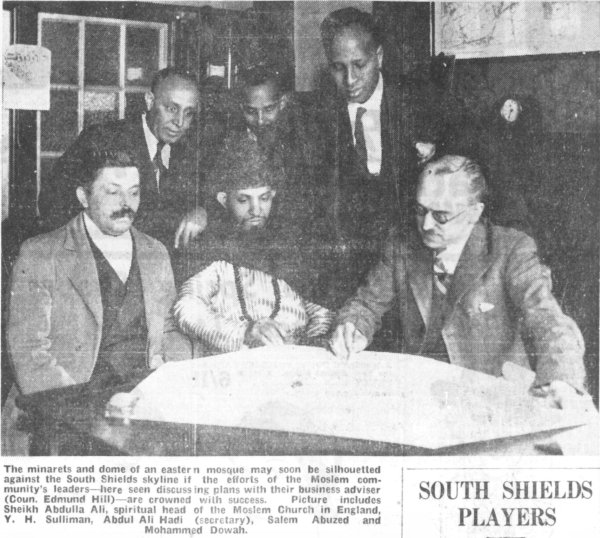
After Cuthbert Street Zaoia
During the ‘slum clearance’ in 1937, the Zaoia Allaouia Islamic was demolished and Muslims were offered space to pray in Laygates reading rooms until they were able to build their own mosque. See photo below
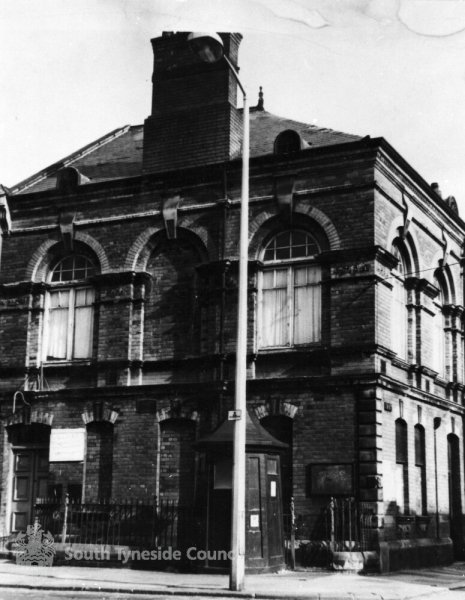
(c) South Tyneside Libraries
The establishment of street processions continued on after the departure of Sheikh Abdullah. (See below)

(c) Shields Gazette 1977
(c) Shields Gazette 30th July 1937
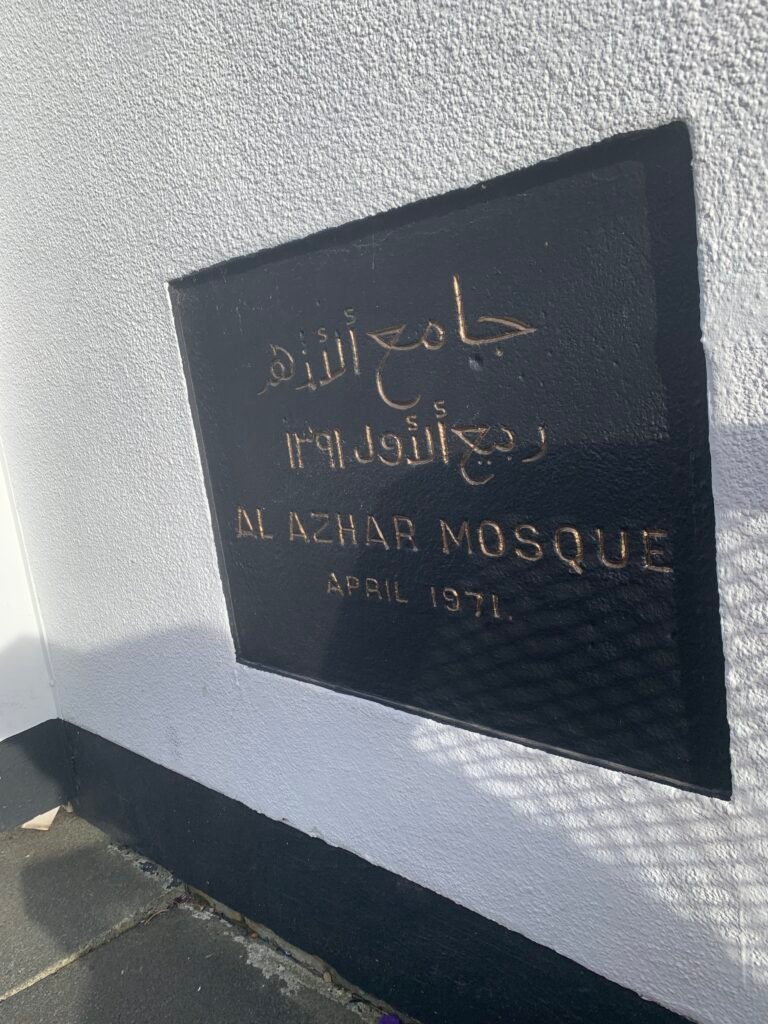
Plaque in Arabic and English still on the Mosque today (c) Leyla Al-Sayadi

Invitation to the open ceremony of the Mosque – c/o address is the boarding house of Mohamed Al-Sayyadi, co-founder. (c) Mariam Fasa
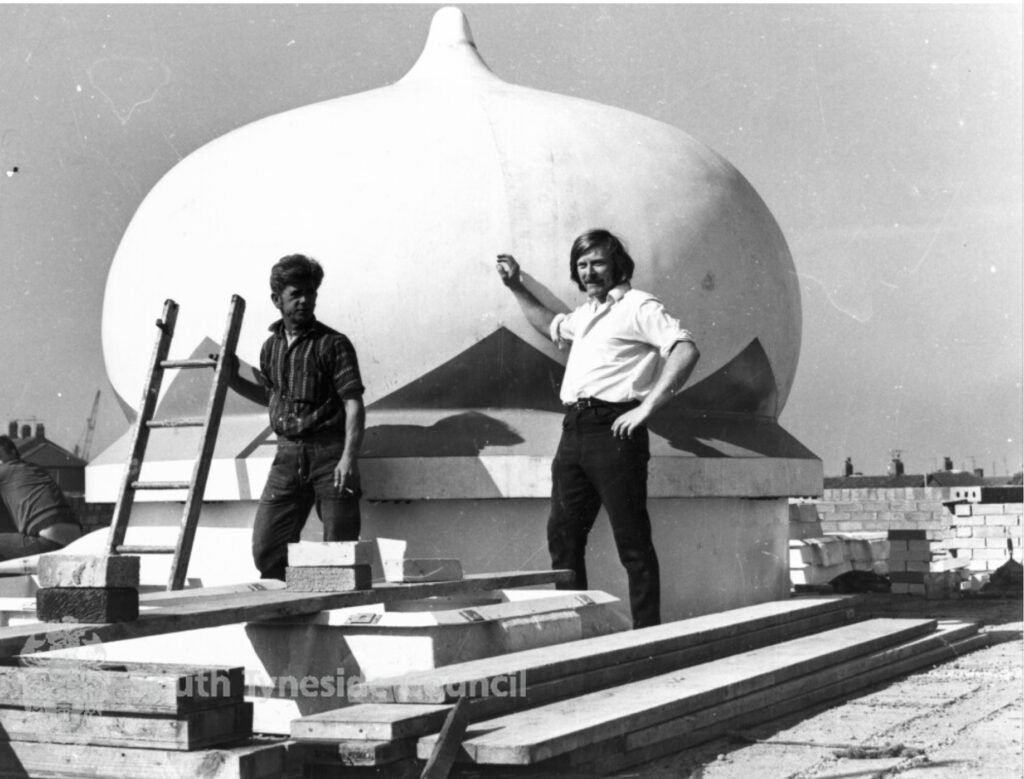
Working on the minaret atop the new Al Azhar Mosque roof (c)South Tyneside Libraries
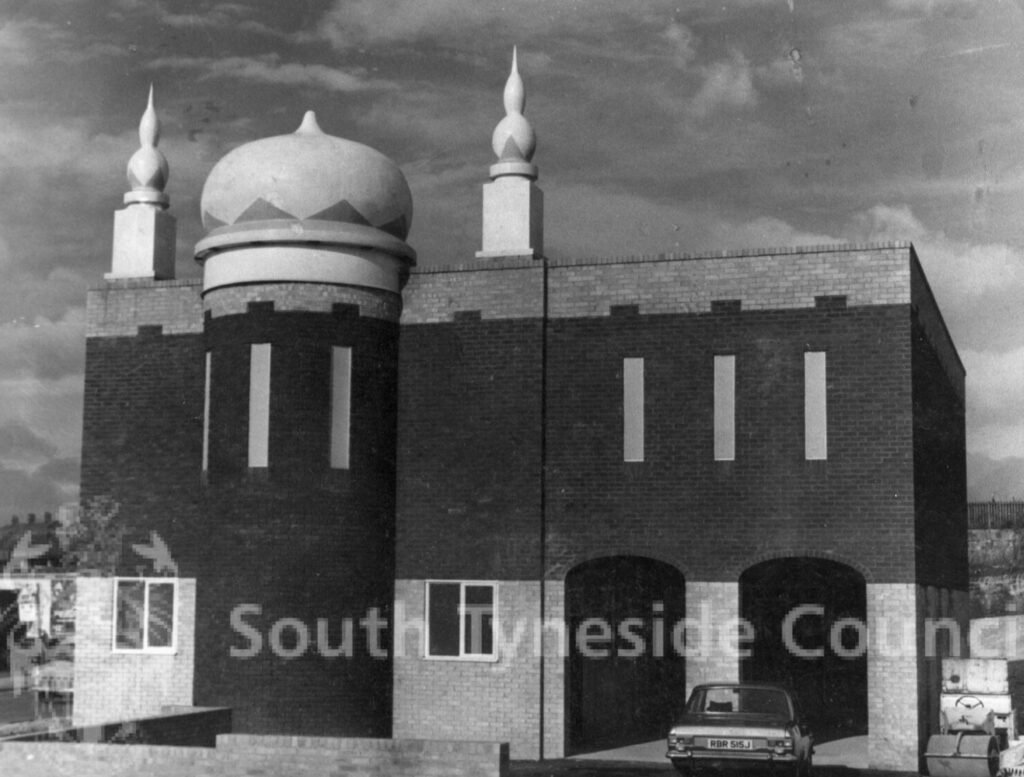
(c) South Tyneside Libraries – the Al Azhar Mosque as it was originally built.
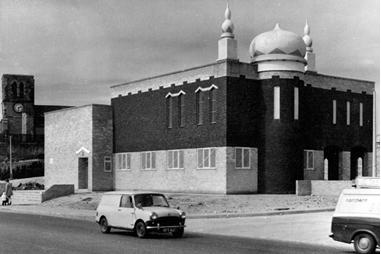
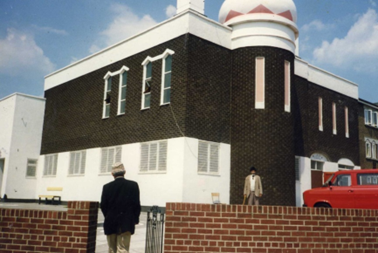
Inspiration. –
An interesting story has been passed down in the community about the the early idea for building a Mosque in South Shields. Some say it was actually initialised by an influx of Turkish Seamen who docked into Tyneside in the early 20th century. There is not much evidence of this claim to hand. The story goes that these seamen did not stay and make South Shields their home as the Yemeni seafaring community did but one Eid they were looking for somewhere to pray. They decided to look at some houses to see if they could find one for the Eid prayer but there was not a house was big enough to accommodate them all. They therefore had to use many houses and split themselves up to perform the prayer which motivated them to start fundraising to build one Mosque for the whole Muslim community.
Early fundraising
Initially, they lay scarves down on the floor of these ‘Zaoias’ (buildings used as Mosques) for people to put money on. They managed through this method to collect about £500 which they then used to buy land from the council. By this time the Yemeni community were actively involved and took forward the work started by the Turks. A prominent figure in the community known as Obeya looked after the money and found land on the corner of Commercial Road. Building started and foundations were put in place but this was interrupted by the council who decided they had need for the land and would instead offer them land next to Holy Trinity Church. This is the site of the Al Azhar Mosque as we see it today.
Fundraising from the Arab World.
We do know factually, that a Saudi architect helped to develop the plans for the Mosque and building commenced. With half of the Mosque built by funds raised locally, the money ran out. The Yemeni community then wrote letters to charities and governments around the Middle East and Africa asking for help. They went to the Yemen Embassy and were given £500. Other countries that donated include Somalia, Saudi Arabia, the UAE (Dubai gave £30,000) and Kuwait. The Yemenis were helped by some Kuwaiti students living in South Shields including Jassim Al Monsouri who went to Kuwait to help get money for the Mosque. Mohamed Ahmed Al-Sayyadi (Ahmed Ali Hussein) as chairman of the Islamic Trust went personally to Saudi Arabia, Kuwait and Yemen to help raise money. Donations largely came as pledges first with cheques being sent over to the UK later. The Yemeni community of the UK also donated including communities in Sheffield and Liverpool. Money was given bit by bit and pictures were sent to financial backers to show the progress of the building in order to obtain more funding.
Local figures
Those involved primarily in the building of the Mosque included Mohamed Ahmed Al-Sayyadi (Hussein), Abdul Ghani Mohamed, Abdo Mohamed Al Khulaidi and Mr Shah. The Mosque was named and the inscription put in stone on the side of the building in 1973. It can still be seen today.
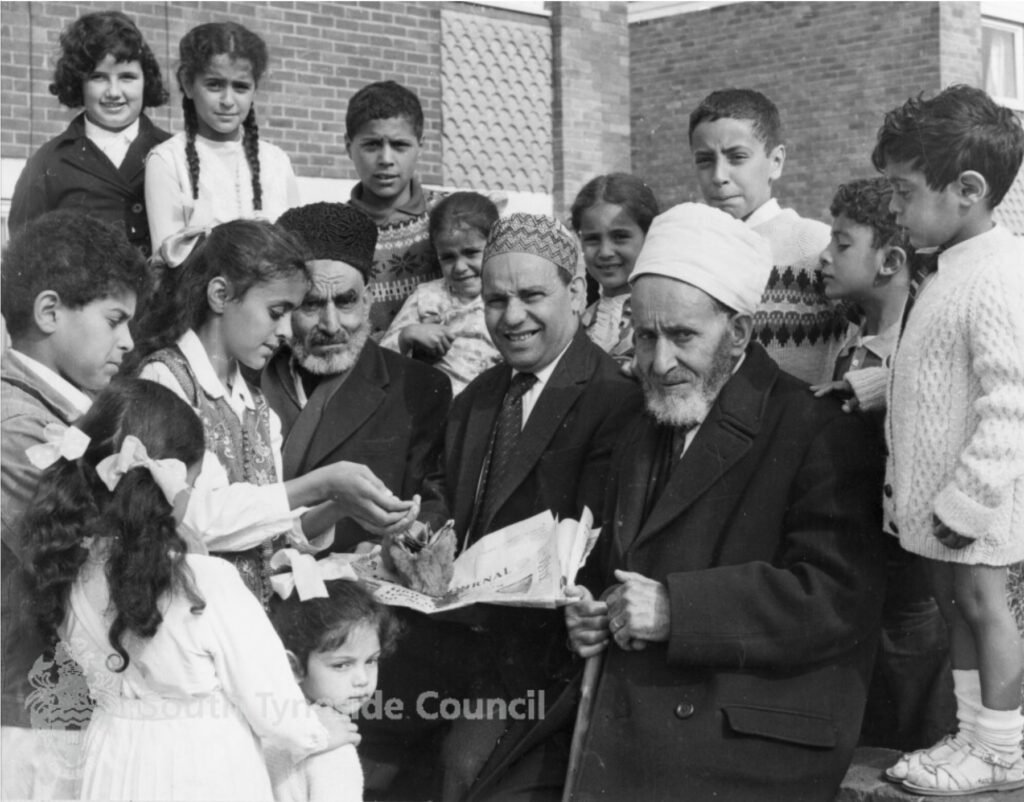
(c) South Tyneside Libraries. – Obeya, Mohamed Ahmed Al-Sayyadi and Abdo Ali collecting money for the new mosque
Sheikh Abdel Salam Mraish
(c) Sheila Graber
Sheikh Abdel Salam Mraish was a Palestinian who served at Al Azhar Mosque during the 1980s. He delivered sermons (Khutbas), lead prayers, taught children and did much good in the wider local community. May Allah swt accept these deeds from him. Local artist Sheila Graber created an animation in the 1980s called ‘New Year Around the World’ with a voice recording from Sheikh Abdelsalam . She narrates that he told her, ‘In Saudi I would stand outside on the minaret and sing to welcome the new year but in Sheilds it is far too cold’.
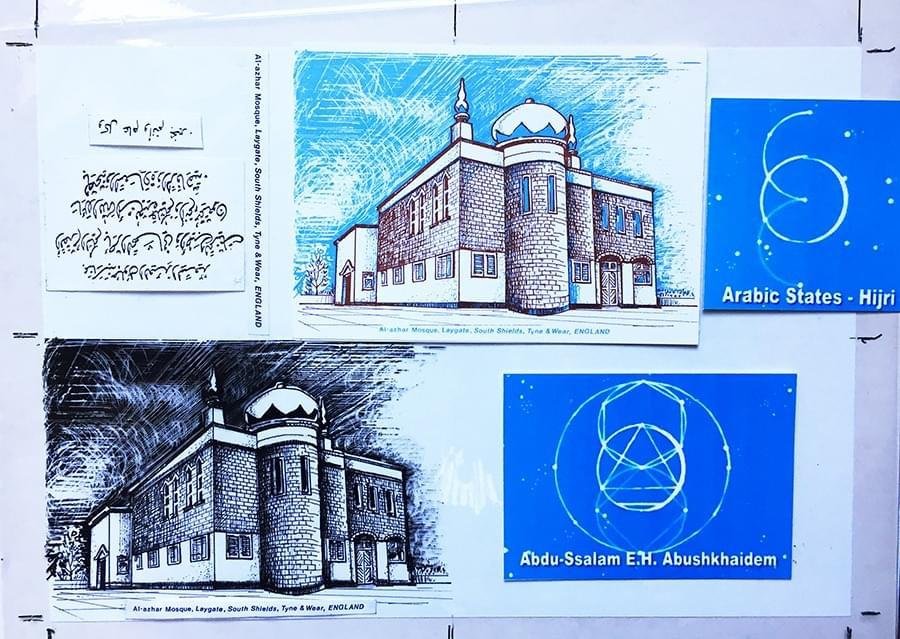
Sheikh Abdel Salam asked local artist Sheila Graber to design a card for the mosque which she did at his request (c) Sheila Graber
(c) Leyla Al-Sayadi
The Sheikh left South Shields to be the sheikh in London Central Mosque but visited South Shields infrequently. This is a recording from his address to Al Azhar Mosque school children in 2017.

(c) Leyla Al-Sayadi
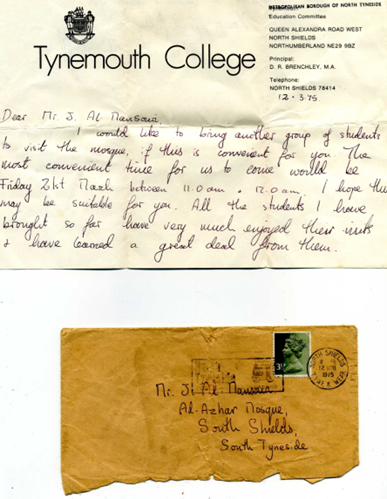
An excerpt showing a school visit from the Shields Gazette is below.
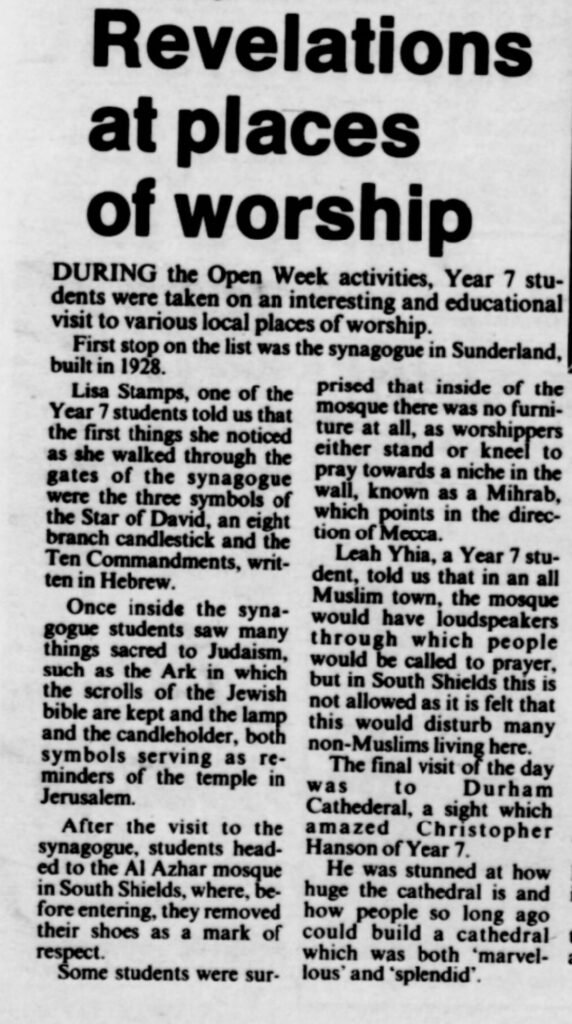
(c) Shields Gazette 24/06/1992
1990s
The Mosque during the 90s was bursting with activity which is recorded in the local newspaper. Since its founding, members of the mosque committee were appointed by open and fair election processes. These were often publicised with full transparency. These are the names of the founders and people who worked hard to make the Mosque a success for the generations which follow today.
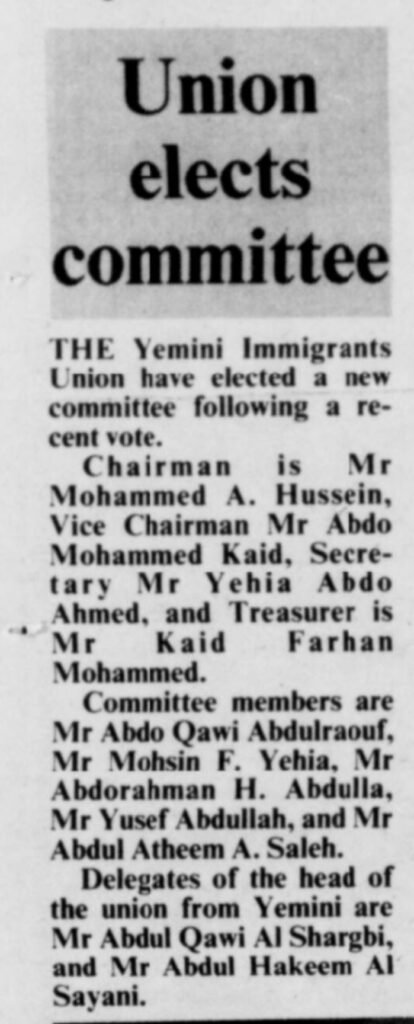
(c) The Shields Gazette 27/09/1991
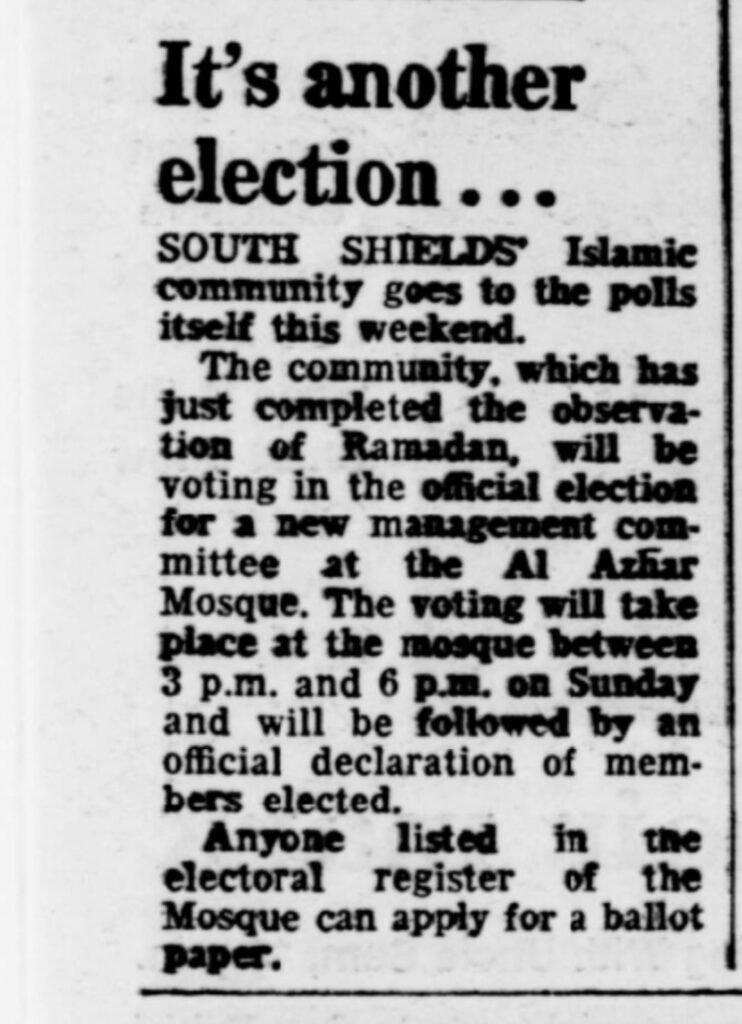
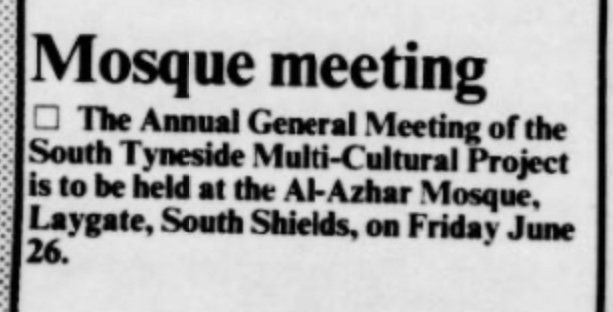
(c) The Shields Gazette 17/06/1992
27/09/1991 (c) The Shields Gazette
Working with the local community
The Mosque also opened its door for many educational activities across the wider community as well as putting on specific Quran and Islamic teaching for Muslims.

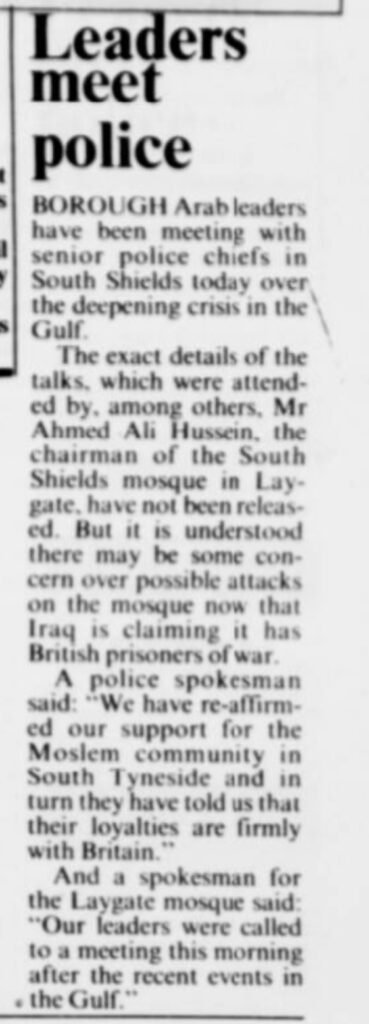
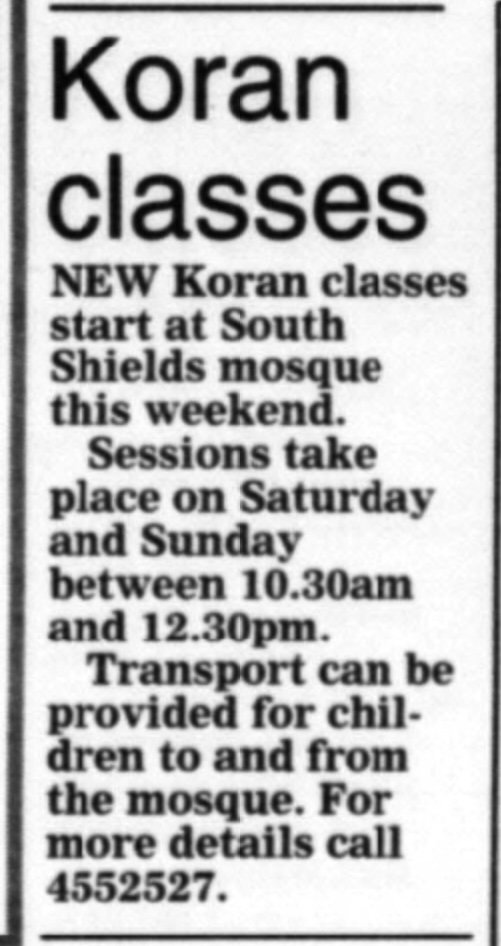
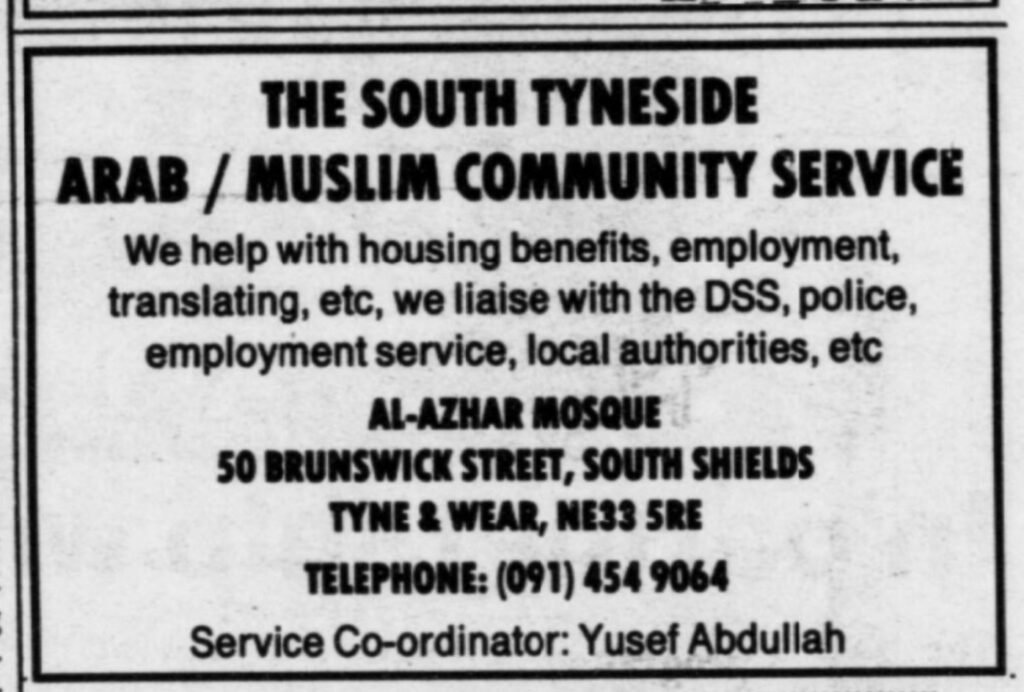
(c) Shields Gazette 14/10/1993
Local interest in islam

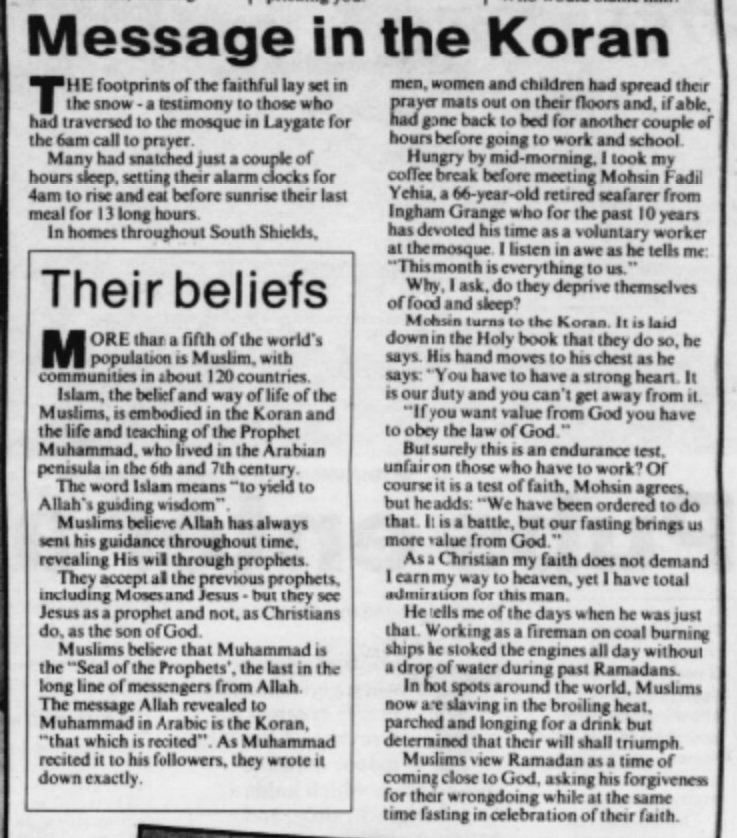
(c) The Shields Gazette 14/11/1995
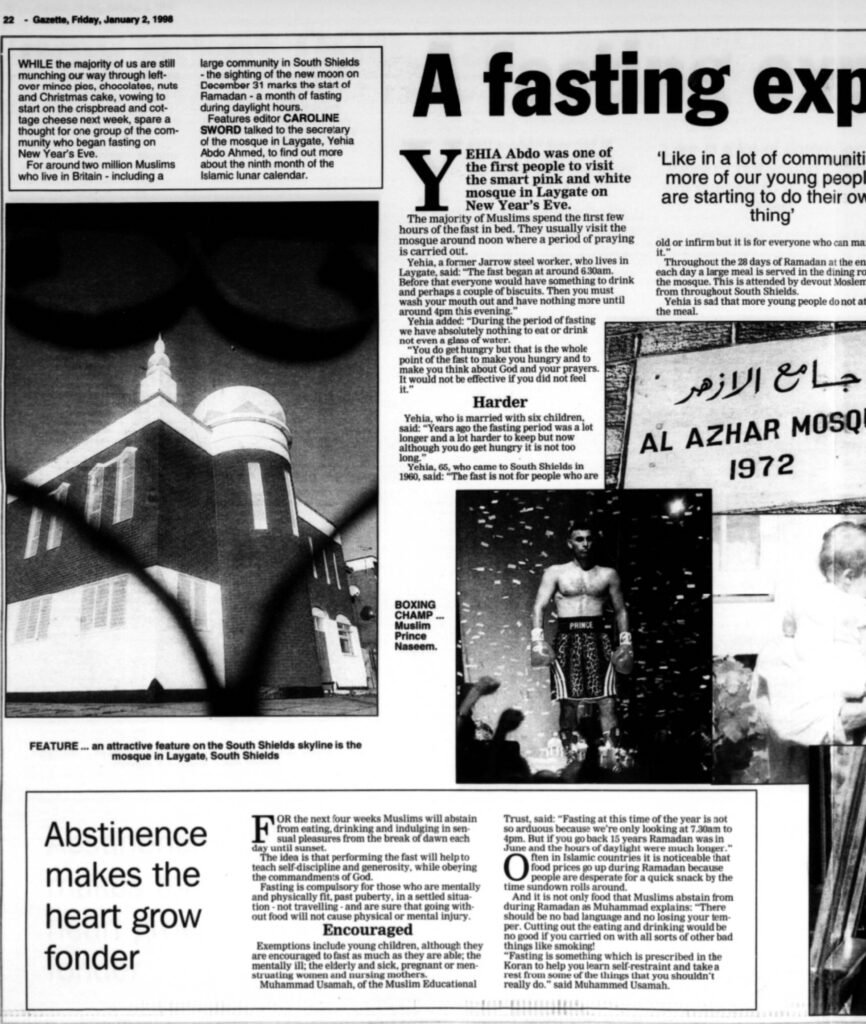
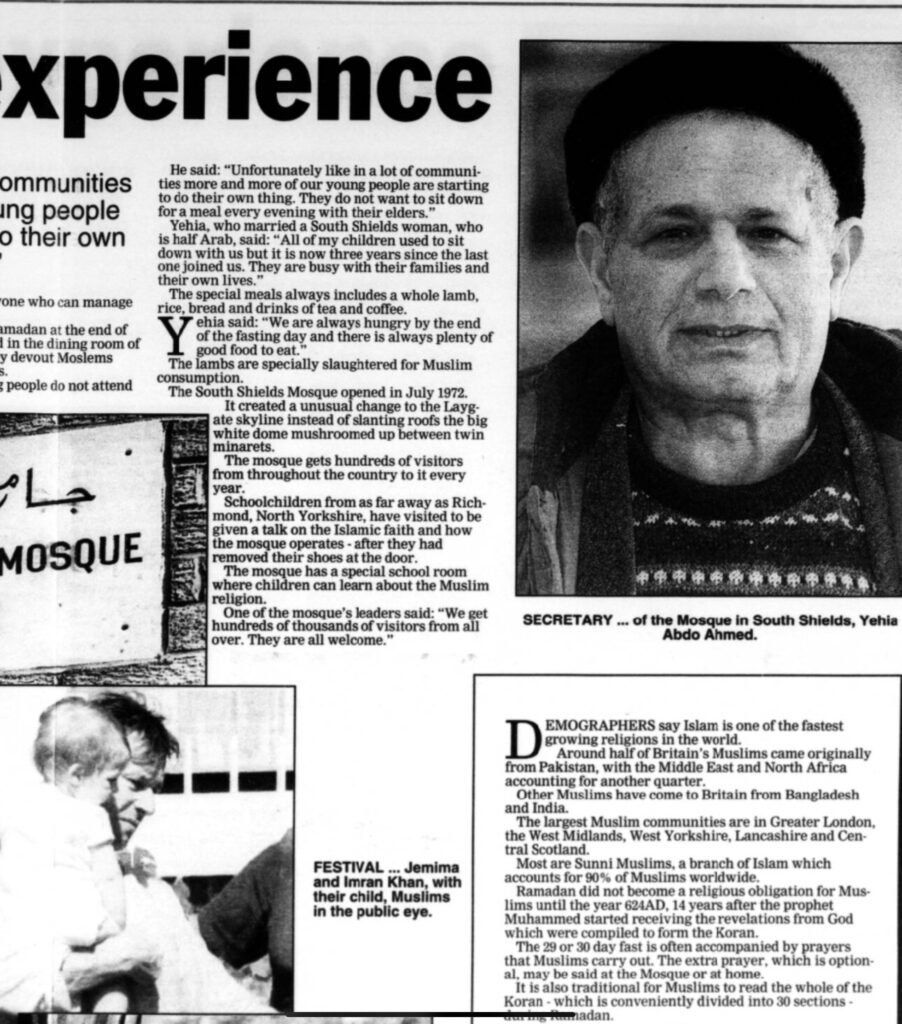
(c) The Shields Gazette 02/01/1998
In full:

Continued progress
Following the establishment of the Moque, the committee continued to strengthen its position and take it to the next level by building flats next to the Mosque in 1988, getting the Mosque a new roof and providing a minibus to help children in the community attend to their classes.
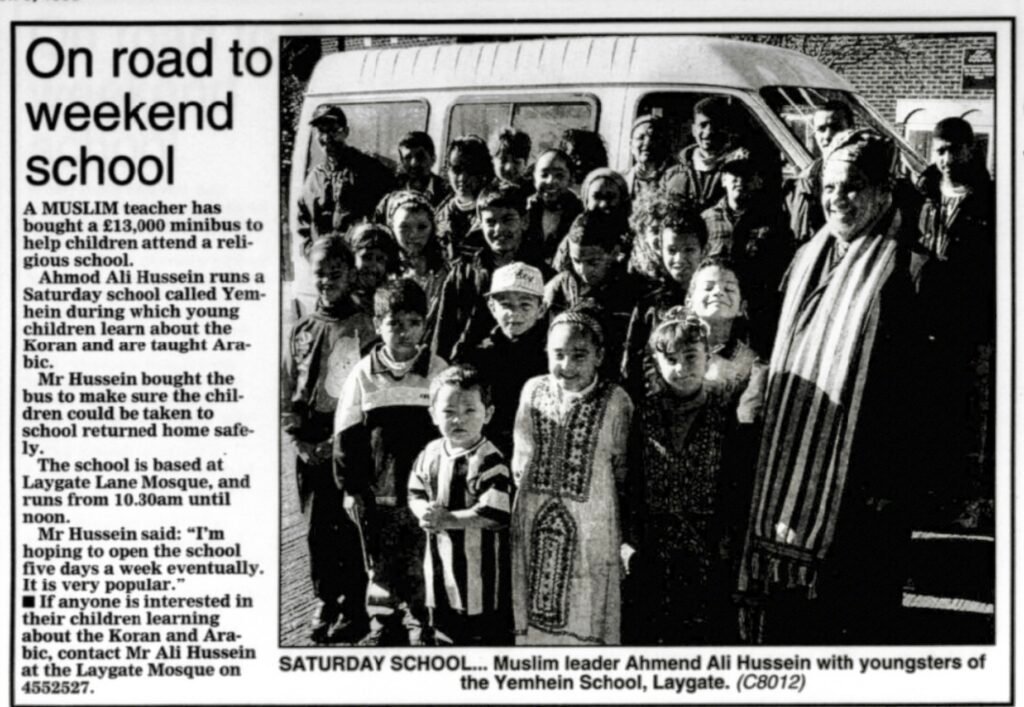
(c) Shields Gazette 03/03/1998
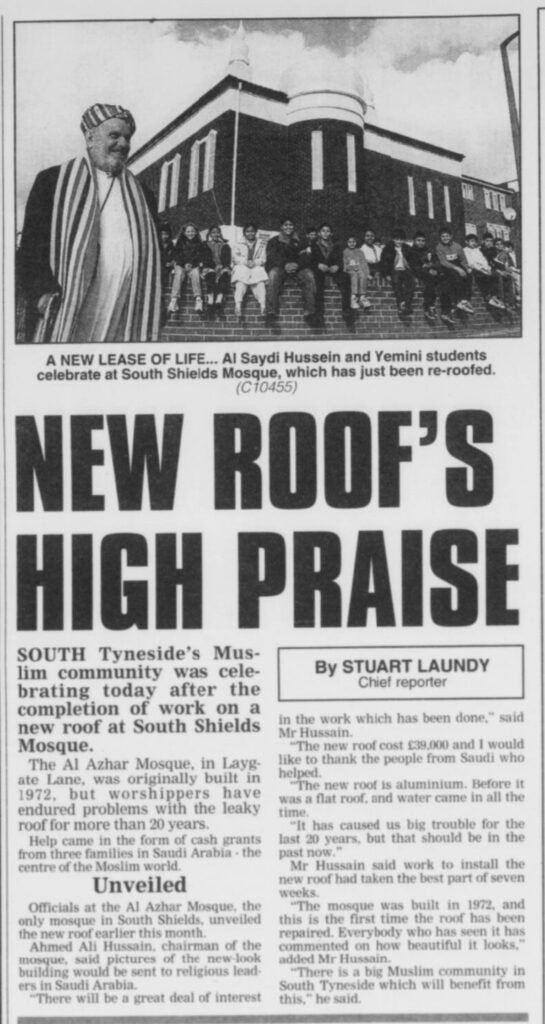
(c) Shields Gazette 13/10/1998
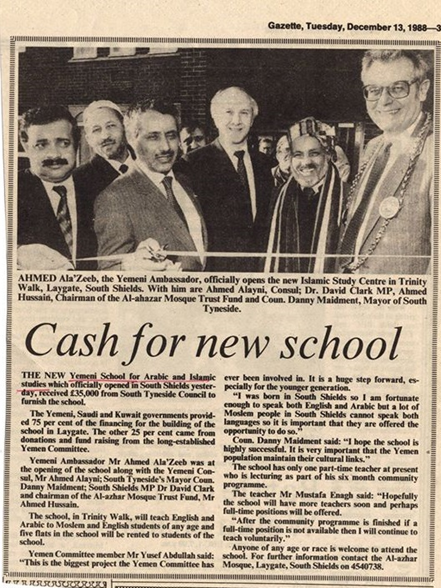
Gazette article dated December 13th 1988 to advertise the opening of the new school building next to the Mosque. © The Shields Gazette 13/12/1988
A snapshot of how the community looked in 2008 can be seen through this photo by Tina Gharavi in her work, Last of the Dictionary men. This work focused on the last 13, 1st generation of seamen in South Shields. Many pictured on the photo below are no longer with us and prayers for their forgiveness are sought. (c)Tina Gharavi

‘Last of the Dictionary Men’
As with the boarding houses, an important point of contact for the Yemeni community has always been Al-Azhar Mosque in Laygate, South Shields.
Academic and filmmaker, Tina Gharavi brought technology and storytelling to the heart of the Yemeni community when putting together an oral history project focused on the 13 remaining 1st generation Yemeni seamen which culminated in an exhibition in 2008.
Gharavi commissioned Yusef Nabil, a celebrated Egyptian photographer, to undertake portraits of the men. The exhibition included these hand-tinted images, oral history Tina had recorded of the men, as well a further film also called “Last of the Dictionary Men”.
Her exhibition was displayed alongside another documentary on Muhammad Ali’s visit to South Shields in 1977 called “The King of South Shields”. The show opened at the BALTIC Centre for Contemporary Art, Gateshead, then travelled to several cities in Yemen, first opening in the capital in Sana’a, and later returning to the UK in 2013 in London where it closed.
Additionally, a book was published about the work which had captured the stories of an almost lost generation and brought this unique and vital story to the world.
Much of Tina’s work took place in the Mosque in 2008
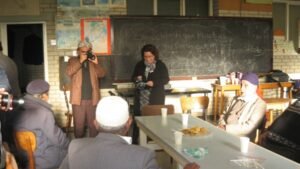

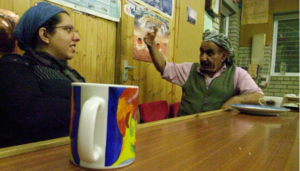
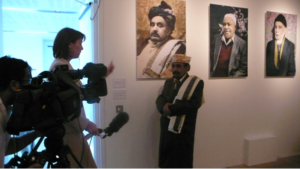
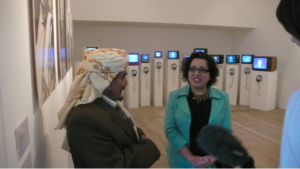
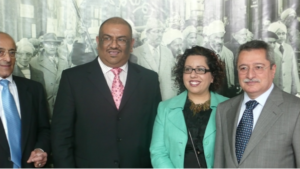
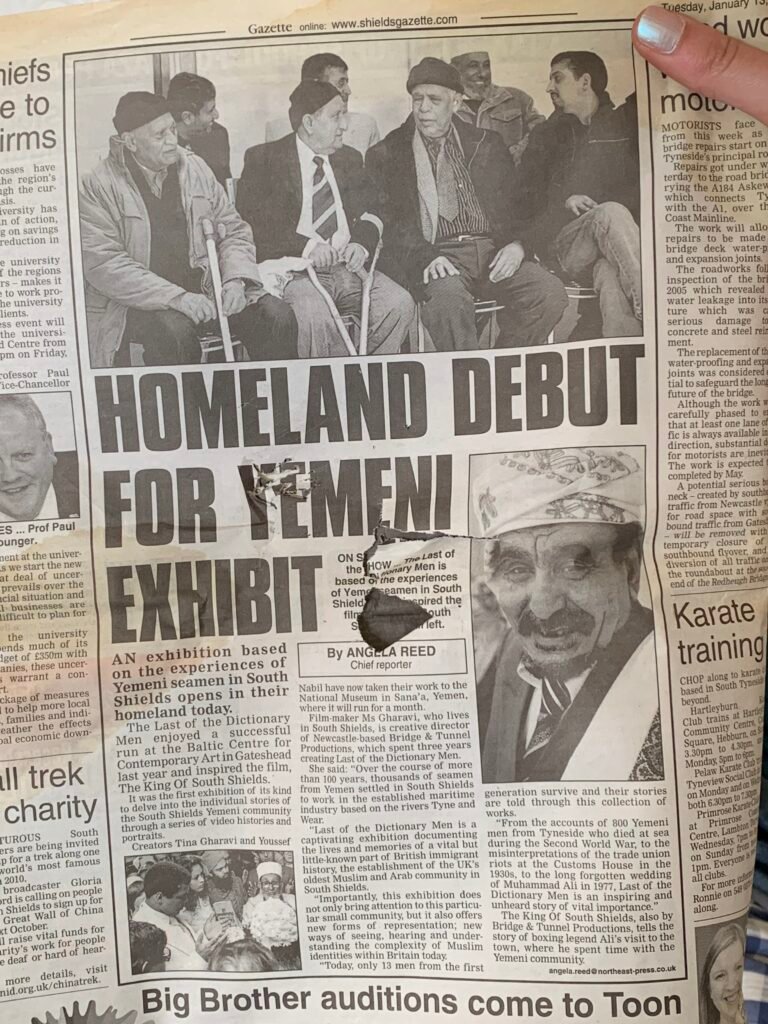

Annual open evenings – to the present day
The current mosque committee and their volunteers continue to follow in their predecessors footsteps and open the doors to interfaith dialogue which is a teaching of the Islamic faith.
“Invite all to the way of your Lord with wisdom and beautiful preaching; and engage with them in ways that are best and most gracious” Quran – (16:125)
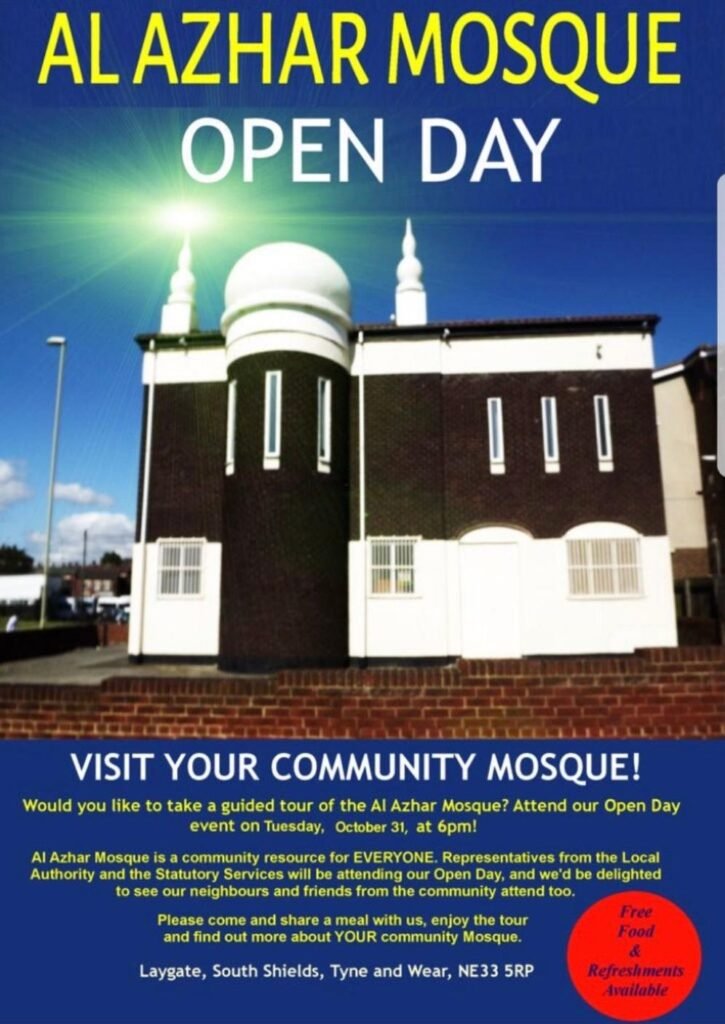

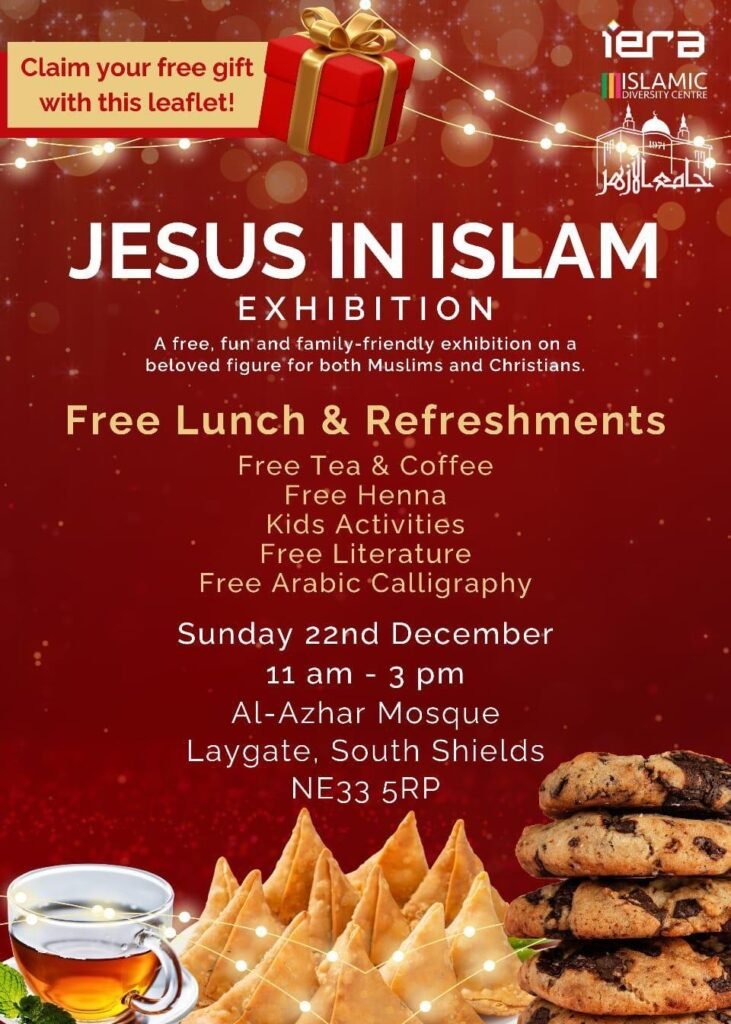

Jesus in Islam Exhibition – December 2024

Councillors visit during ramadan

Simonside and Rekendyke ward councillors visit the mosque during Ramadan 2022
serving the community through COVID – 19
During the pandemic, the Mosque played an active role in ensuring that people were able to pray during Ramadan and provided food to people fasting as nobody was able to attend for the usual Iftar (breaking of the fast) meal.
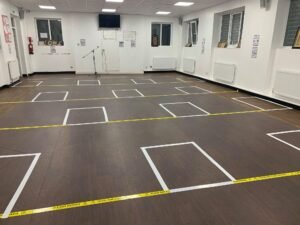


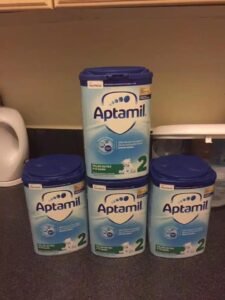
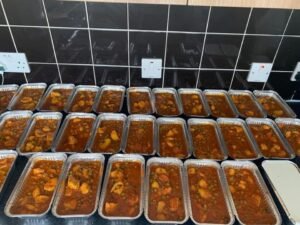

south tyneside council – local list
Al Azhar mosque features on South Tyneside councils local list. This is a list of buildings in the borough with agreed significant historical importance. It also includes local landmarks and good examples of local architecture.
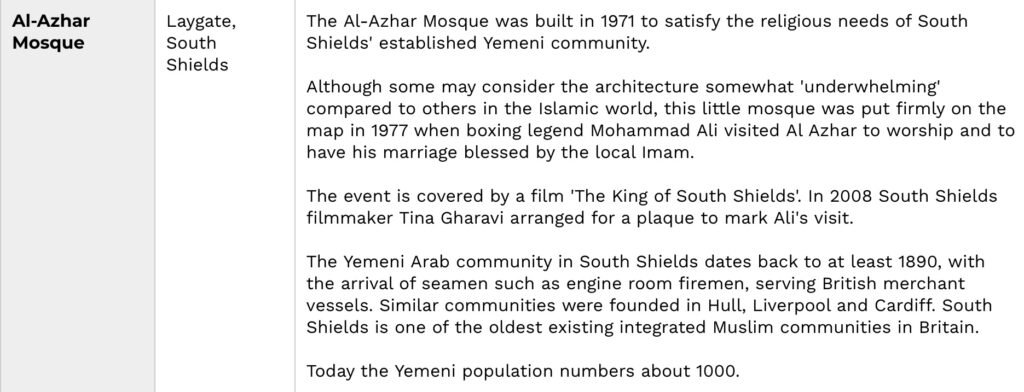
Local List 15
- (c) The Shields Gazette https://www.shieldsgazette.com
↩︎ - Ibid ↩︎
- Ibid ↩︎
- Ibid ↩︎
- Ibid ↩︎
- Ibid ↩︎
- Ibid ↩︎
- Ibid ↩︎
- Ibid ↩︎
- Ibid ↩︎
- Ibid ↩︎
- Wikipedia. (2024). Aga Khan III. [online] Available at: https://en.wikipedia.org/wiki/Aga_Khan_III. ↩︎
- (c) The Shields Gazette https://www.shieldsgazette.com 27/07/1992 ↩︎
- Ibid ↩︎
- South Tyneside Council. (2020). Local List A to Z – South Tyneside Council. [online] Available at: https://www.southtyneside.gov.uk/article/18506/Local-List-A-to-Z [Accessed 28 Jul. 2025].
↩︎


